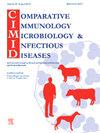Molecular epidemiology of feline calicivirus (FCV) and felid alphaherpesvirus 1 (FeAHV-1) in cats with clinical signs and clinically healthy cats
IF 2
3区 农林科学
Q4 IMMUNOLOGY
Comparative Immunology Microbiology and Infectious Diseases
Pub Date : 2025-07-09
DOI:10.1016/j.cimid.2025.102383
引用次数: 0
Abstract
Feline Calicivirus (FCV) and Felid Alphaherpesvirus 1 (FeAHV-1), commonly detected in cats, are significant viral pathogens causing upper respiratory tract disease (URTD) and various clinical signs. Co-infection with both viruses is common and a major problem in feline health worldwide. This study investigated the presence and prevalence of both FCV and FeAHV-1 in suspected cats with either clinically healthy or clinical signs in relation to various parameters related to the sampled animals. A total of 331 diagnostic samples (conjunctival, nasal, and oropharyngeal swabs, and EDTA blood samples) were collected from 107 cats and examined using PCR. FCV nucleic acid was detected in cats 33.64 % (36/107), while FeAHV-1 nucleic acid was found 64.48 % (69/107). Of the cats with clinical signs (n = 31), 48.38 % (15/31) and 74.19 % (23/31) were positive for FCV and FeAHV-1, respectively, while 27.63 % (21/76) and 60.52 % (46/76) of the clinically healthy cats (n = 76) were positive for FCV and FeAHV-1, respectively. The overall positivity rates for FCV and FeAHV-1 were 90.32 % (28/31) in cats with clinical signs and 72.36 % (55/76) in clinically healthy cats, respectively. Additionally, 20.33 % (12/59) of vaccinated cats were positive for FCV and 64.40 % (38/59) for FeAHV-1, whereas 48.88 % (22/45) of unvaccinated cats were positive for FCV and 66.67 % (30/45) for FeAHV-1. The results indicate that both infections are prevalent among clinical and/or clinically healthy, vaccinated/unvaccinated cats. This indicates that clinically healthy cats may play a significant role in the epidemiology of these infections, and that vaccination may not provide complete protection against FCV and FeAHV-1 infection.
猫杯状病毒(FCV)和猫甲疱疹病毒1型(FeAHV-1)在临床症状猫和临床健康猫中的分子流行病学研究
猫Calicivirus (FCV)和Felid Alphaherpesvirus 1 (FeAHV-1)是一种常见的病毒性病原体,可引起上呼吸道疾病(URTD)和各种临床症状。同时感染这两种病毒是很常见的,也是全世界猫科动物健康的一个主要问题。本研究调查了与样本动物相关的各种参数相关的临床健康或临床症状的疑似猫中FCV和FeAHV-1的存在和流行情况。从107只猫身上收集了331份诊断样本(结膜、鼻腔和口咽拭子以及EDTA血液样本),并使用PCR进行了检测。猫中检出FCV核酸33.64 % (36/107),FeAHV-1核酸64.48 %(69/107)。在有临床症状的猫(n = 31)中,FCV和FeAHV-1的阳性率分别为48.38 %(15/31)和74.19 %(23/31),而临床健康猫(n = 76)中FCV和FeAHV-1的阳性率分别为27.63 %(21/76)和60.52 %(46/76)。临床症状猫的FCV和FeAHV-1总阳性率分别为90.32 %(28/31)和72.36 %(55/76)。此外,20.33% %(12/59)的接种猫FCV和64.40% %(38/59)的FeAHV-1呈阳性,而48.88% %(22/45)的未接种猫FCV和66.67% %(30/45)的FeAHV-1呈阳性。结果表明,这两种感染在临床和/或临床健康、接种疫苗/未接种疫苗的猫中普遍存在。这表明,临床健康的猫可能在这些感染的流行病学中发挥重要作用,接种疫苗可能不能完全预防FCV和FeAHV-1感染。
本文章由计算机程序翻译,如有差异,请以英文原文为准。
求助全文
约1分钟内获得全文
求助全文
来源期刊
CiteScore
4.60
自引率
0.00%
发文量
102
审稿时长
40 days
期刊介绍:
Comparative Immunology, Microbiology & Infectious Diseases aims to respond to the concept of "One Medicine" and to provide a venue for scientific exchange. Based on the concept of "Comparative Medicine" interdisciplinary cooperation between specialists in human and animal medicine is of mutual interest and benefit. Therefore, there is need to combine the respective interest of physicians, veterinarians and other health professionals for comparative studies relevant to either human or animal medicine .
The journal is open to subjects of common interest related to the immunology, immunopathology, microbiology, parasitology and epidemiology of human and animal infectious diseases, especially zoonotic infections, and animal models of human infectious diseases. The role of environmental factors in disease emergence is emphasized. CIMID is mainly focusing on applied veterinary and human medicine rather than on fundamental experimental research.

 求助内容:
求助内容: 应助结果提醒方式:
应助结果提醒方式:


